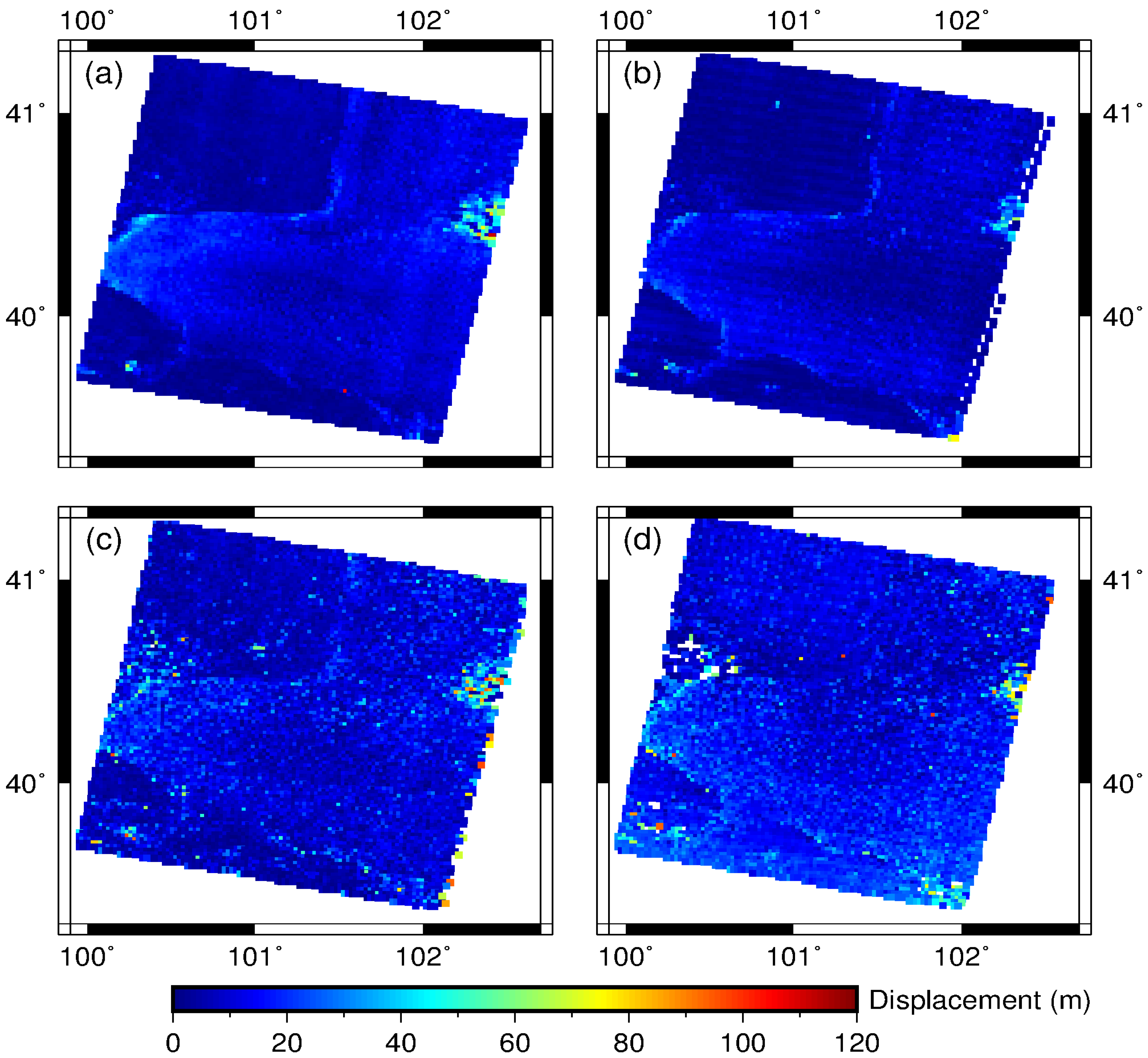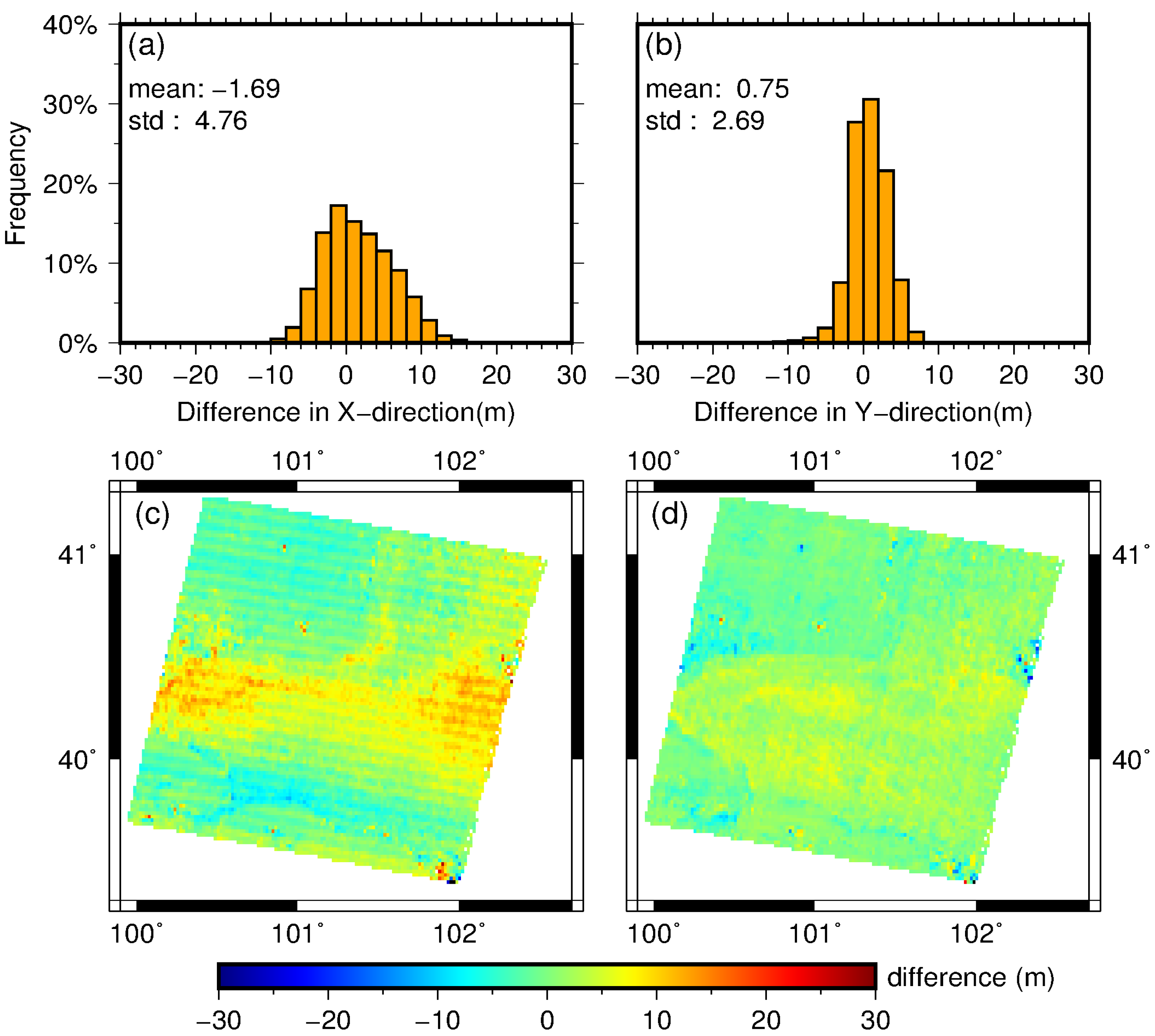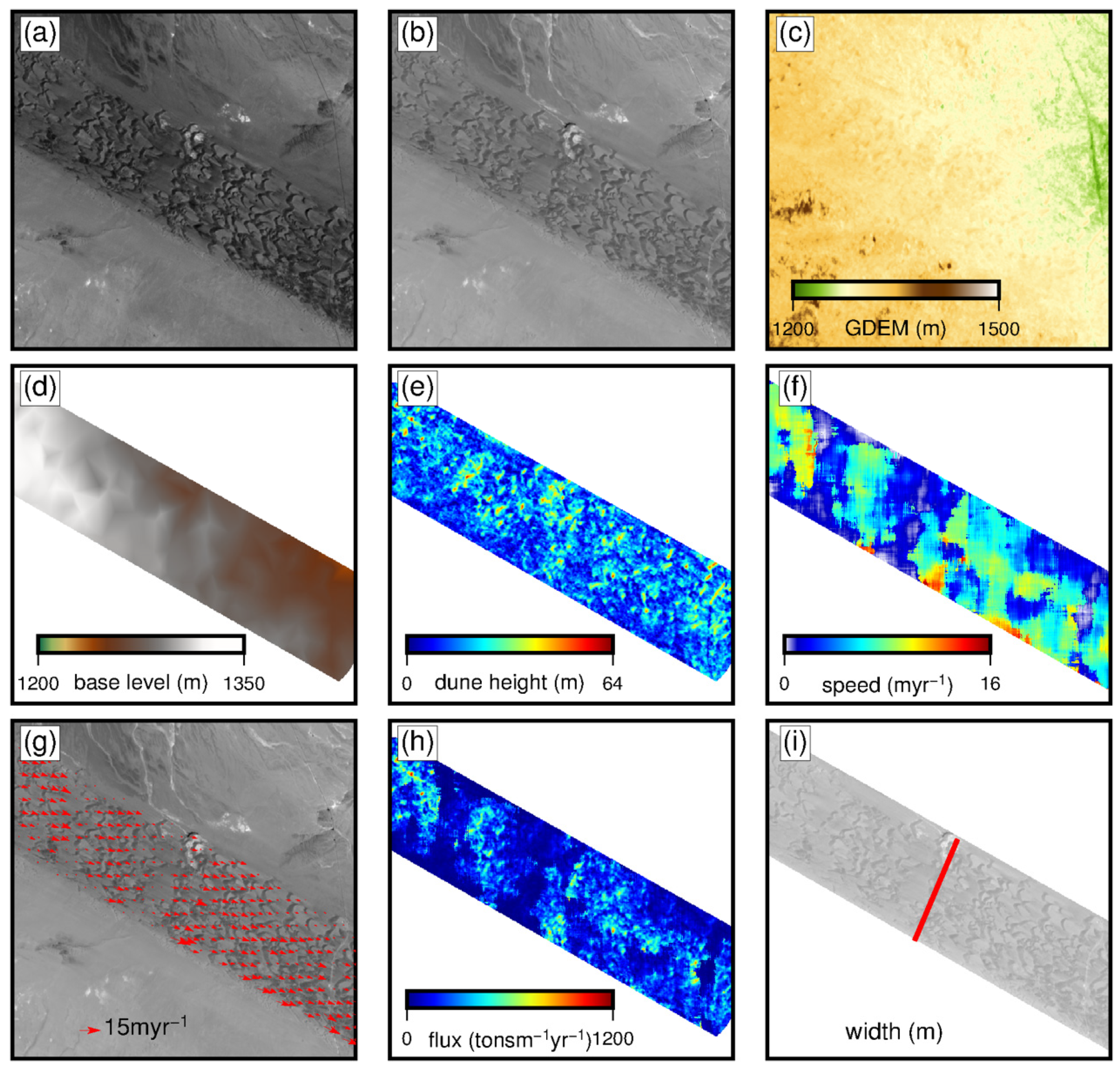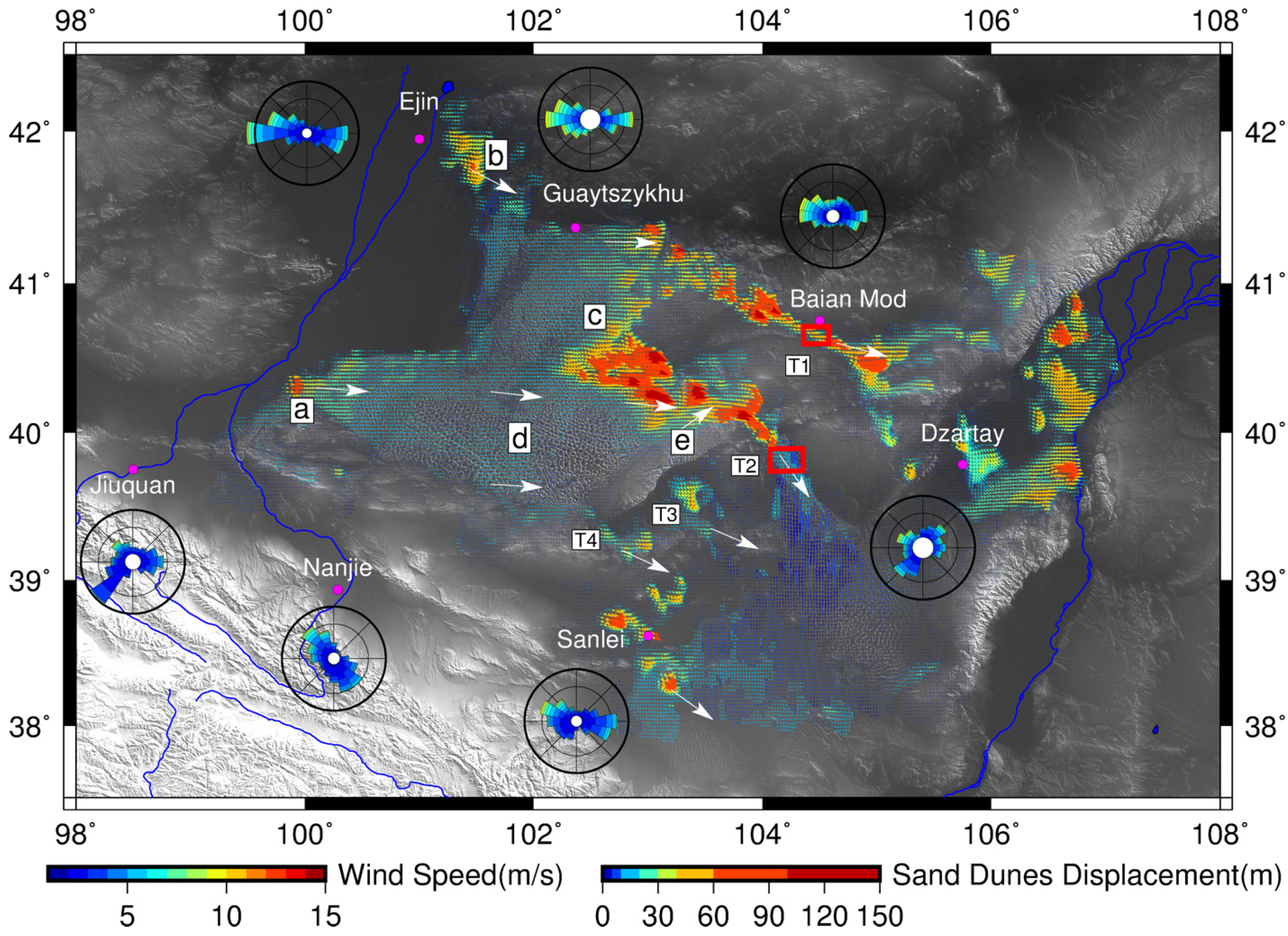Measuring Sand Dune Dynamics in the Badain Jaran Desert, China, Using Multitemporal Landsat Imagery
Abstract
1. Introduction
2. Study Area and Data Sources
2.1. Study Area
2.2. Data Sources
3. Methodology
3.1. Displacement Extraction at Subpixel Accuracy
3.2. Method Validation with Different Landsat Image Pairs
3.3. Measuring Sand Flux
4. Results and Discussion
4.1. Dune Migration
4.1.1. Displacement in the BJD
4.1.2. Displacement Patterns
4.1.3. Sand Transport Tunnels
4.2. Sand Flux
4.3. Displacement Measurement Errors
5. Conclusions
Author Contributions
Funding
Data Availability Statement
Acknowledgments
Conflicts of Interest
References
- Lee, E.-H.; Sohn, B.-J. Recent increasing trend in dust frequency over Mongolia and inner Mongolia regions and its association with climate and surface condition change. Atmos. Environ. 2011, 45, 4611–4616. [Google Scholar] [CrossRef]
- Huadong, G.; Schaber, G.G.; Breed, C.S.; Lewis, A.J. Shuttle imaging radar response from sand dunes and subsurface rocks of Alashan Plateau in North-Central China. In Proceedings of the 7th Symposium on Remote Sensing for Resources Development and Environmental Management, Enschede, The Netherlands, 25–29 August 1986. [Google Scholar]
- Scheidt, S.P.; Lancaster, N. The application of COSI-Corr to determine dune system dynamics in the southern Namib Desert using ASTER Data: Beaver pond sedimentation in the Ardennes, Belgium. Earth Surf. Process. Landf. 2013, 38, 1004–1019. [Google Scholar] [CrossRef]
- Sauber, J.; Thatcher, W.; Solomon, S.C. Geodetic measurement of deformation in the Central Mojave Desert, California. J. Geophys. Res. Solid Earth 1986, 91, 12683–12693. [Google Scholar] [CrossRef]
- Bristow, C.S.; Lancaster, N. Movement of a small slipfaceless dome dune in the Namib Sand Sea, Namibia. Geomorphology 2004, 59, 189–196. [Google Scholar] [CrossRef]
- Jackson, D.W.T. A new, instantaneous aeolian sand trap design for field use. Sedimentology 1996, 43, 791–796. [Google Scholar] [CrossRef]
- Rasmussen, K.R.; Mikkelsen, H.E. On the efficiency of vertical array aeolian field traps. Sedimentology 1998, 45, 789–800. [Google Scholar] [CrossRef]
- Yao, Z.Y.; Wang, T.; Han, Z.W.; Zhang, W.M.; Zhao, A.G. Migration of sand dunes on the northern Alxa Plateau, Inner Mongolia, China. J. Arid Environ. 2007, 70, 80–93. [Google Scholar] [CrossRef]
- Buijsman, M.C.; Ridderinkhof, H. Long-term evolution of sand waves in the Marsdiep Inlet. I: High-resolution observations. Cont. Shelf Res. 2008, 28, 1190–1201. [Google Scholar] [CrossRef]
- Vermeesch, P.; Drake, N. Remotely sensed dune celerity and sand flux measurements of the world’s fastest barchans (Bodélé, Chad). Geophys. Res. Lett. 2008, 35, L24404. [Google Scholar] [CrossRef]
- Ali, E.; Xu, W.; Ding, X. Spatiotemporal variability of dune velocities and corresponding uncertainties, detected from optical image matching in the North Sinai Sand Sea, Egypt. Remote Sens. 2021, 13, 3694. [Google Scholar] [CrossRef]
- Leprince, S.; Barbot, S.; Ayoub, F.; Avouac, J.-P. Automatic and precise orthorectification, coregistration, and subpixel correlation of satellite images, application to ground deformation measurements. Geosci. Remote Sens. IEEE Trans. 2007, 45, 1529–1558. [Google Scholar] [CrossRef]
- Scherler, D.; Leprince, S.; Strecker, M. Glacier-surface velocities in alpine terrain from optical satellite imagery—Accuracy improvement and quality assessment. Remote Sens. Environ. 2008, 112, 3806–3819. [Google Scholar] [CrossRef]
- Burns, P.; Nolin, A. Using atmospherically-corrected Landsat imagery to measure glacier area change in the Cordillera Blanca, Peru from 1987 to 2010. Remote Sens. Environ. 2014, 140, 165–178. [Google Scholar] [CrossRef]
- Hermas, E.; Leprince, S.; El-Magd, I.A. Retrieving sand dune movements using sub-pixel correlation of multi-temporal optical remote sensing imagery, Northwest Sinai Peninsula, Egypt. Remote Sens. Environ. 2012, 121, 51–60. [Google Scholar] [CrossRef]
- Bridges, N.T.; Bourke, M.C.; Geissler, P.E.; Banks, M.E.; Colon, C.; Diniega, S.; Golombek, M.P.; Hansen, C.J.; Mattson, S.; McEwen, A.S.; et al. Planet-wide sand motion on Mars. Geology 2012, 40, 31–34. [Google Scholar] [CrossRef]
- Manzoni, M.; Molinari, M.E.; Monti-Guarnieri, A. Multitemporal InSAR coherence analysis and methods for sand mitigation. Remote Sens. 2021, 13, 1362. [Google Scholar] [CrossRef]
- Ding, C.; Zhang, L.; Liao, M.; Feng, G.; Dong, J.; Ao, M.; Yu, Y. Quantifying the spatio-temporal patterns of dune migration near Minqin Oasis in Northwestern China with time series of Landsat-8 and Sentinel-2 observations. Remote Sens. Environ. 2020, 236, 111498. [Google Scholar] [CrossRef]
- Roy, D.; Wulder, M.; Loveland, T.; CE, W.; Allen, R.; Anderson, M.; Helder, D.; Irons, J.; Johnson, D.; Kennedy, R.; et al. Landsat-8: Science and product vision for terrestrial global change research. Remote Sens. Environ. 2014, 145, 154–172. [Google Scholar] [CrossRef]
- Chen, F.; Liu, Y. Secular annual movement of sand dunes in Badain Fijaran Desert based on geographic analyses of remotely sensed imagery. Remote Sens. Technol. Appl. 2011, 26, 501–507. [Google Scholar]
- Yang, Y. Aeolian Landform Processes in the Main Sand Transport Passages of the Alax Plateau, China. Ph.D. Thesis, Beijing Normal University, Beijing, China, 2015. [Google Scholar]
- Yang, Y.; Qu, Z.; Shi, P.; Liu, L.; Zhang, G.; Tang, Y.; Hu, X.; Lv, Y.; Xiong, Y.; Wang, J.; et al. Wind regime and sand transport in the corridor between the Badain Jaran and Tengger Deserts, Central Alxa Plateau, China. Aeolian Res. 2014, 12, 143–156. [Google Scholar] [CrossRef]
- Walker, A.S.; Olsen, J.W. Bagen The Badain Jaran Desert: Remote sensing investigations. Geogr. J. 1987, 153, 205–210. [Google Scholar] [CrossRef]
- Dong, Z.; Qian, G.; Lv, P.; Hu, G. Investigation of the sand sea with the tallest dunes on Earth: China’s Badain Jaran Sand Sea. Earth-Sci. Rev. 2013, 120, 20–39. [Google Scholar] [CrossRef]
- Jiao, J.J.; Zhang, X.; Wang, X. Satellite-based estimates of groundwater depletion in the Badain Jaran Desert, China. Sci. Rep. 2015, 5, 8960. [Google Scholar] [CrossRef] [PubMed]
- Kurosaki, Y.; Mikami, M. Recent frequent dust events and their relation to surface wind in East Asia. Geophys. Res. Lett. 2003, 30, 1736. [Google Scholar] [CrossRef]
- Ma, N.; Wang, N.A.; Zhu, J.F.; Chen, X.; Chen, H.; Dong, C. Climate change around the Badain Fijaran Desert in recent 50 Years. J. Desert Res. 2011, 31, 1541–1547. [Google Scholar]
- Fryberger, S.G.; Dean, G. Dune forms and wind regime. In A Study of Global Sand Seas; United States Government Printing Office: Washington, DC, USA, 1979; Volume 1052, pp. 137–169. [Google Scholar]
- Wang, X.; Cai, D.; Sun, J.; Lu, H.; Liu, W.; Qiang, M.; Cheng, H.; Che, H.; Hua, T.; Zhang, C. Contributions of Modern Gobi Desert to the Badain Jaran Desert and the Chinese Loess Plateau. Sci. Rep. 2019, 9, 985. [Google Scholar] [CrossRef]
- Fujisada, H.; Urai, M.; Iwasaki, A. Advanced methodology for ASTER DEM generation. IEEE Trans. Geosci. Remote Sens. 2011, 49, 5080–5091. [Google Scholar] [CrossRef]
- Debella-Gilo, M.; Kääb, A. Sub-pixel precision image matching for measuring surface displacements on mass movements using normalized cross-correlation. Remote Sens. Environ. 2011, 115, 130–142. [Google Scholar] [CrossRef]
- Heid, T.; Kääb, A. Evaluation of existing image matching methods for deriving glacier surface displacements globally from optical satellite imagery. Remote Sens. Environ. 2012, 118, 339–355. [Google Scholar] [CrossRef]
- Guizar-Sicairos, M.; Thurman, S.T.; Fienup, J.R. Efficient subpixel image registration algorithms. Opt. Lett. 2008, 33, 156–158. [Google Scholar] [CrossRef]
- Barrett, H.H.; Myers, K.J. Foundations Of Image Science; Wiley: New York, NY, USA, 2003. [Google Scholar]
- Fitch, A.J.; Kadyrov, A.; Christmas, W.J.; Kittler, J. Orientation Correlation. In Proceedings of the BMVC, Cardiff, UK, 2 September 2002; pp. 1–10. [Google Scholar]
- Bagnold, R.A. The Physics of Blown Sand and Desert Dunes; Courier Corporation: Chelmsford, MA, USA, 2012. [Google Scholar]
- Ould Ahmedou, D.; Ould Mahfoudh, A.; Dupont, P.; Ould El Moctar, A.; Valance, A.; Rasmussen, K.R. Barchan dune mobility in Mauritania related to dune and interdune sand fluxes. J. Geophys. Res. Earth Surf. 2007, 112, F02016. [Google Scholar] [CrossRef]
- Chen, H. Weather Monitoring and Preliminary Study of Climate Feature in the Badain Jaran Desert. Ph.D. Thesis, Lanzhou University, Lanzhou, China, 2011. [Google Scholar]
- Liu, T.; Yang, X.; Dong, J.; Fan, X.Y.; Li, H.W.; Zhu, B.Q. A preliminary study of relation between megadune shape and wind regime in the Badain Fijaran Desert. J. Desert Res. 2010, 30, 1285–1291. [Google Scholar]
- Wiggs, G.F.S. Sand Dune Dynamics: Field Experimentation, Mathematical Modelling and Wind Tunnel Testing. Ph.D. Thesis, University of London, London, UK, 1992. [Google Scholar]
- Gill, T.; Collett, L.; Armston, J.; Eustace, A.; Danaher, T.; Scarth, P.; Flood, N.; Phinn, S. Geometric correction and accuracy assessment of Landsat-7 ETM+ and Landsat-5 TM imagery used for vegetation cover monitoring in Queensland, Australia from 1988 to 2007. J. Spat. Sci. 2010, 55, 273–287. [Google Scholar] [CrossRef]
- Leprince, S.; Ayoub, F.; Klingert, Y.; Avouac, J.-P. Co-Registration of Optically Sensed Images and Correlation (COSI-Corr): An Operational Methodology for Ground Deformation Measurements. In Proceedings of the Geoscience and Remote Sensing Symposium, Barcelona, Spain, 23–27 July 2007. [Google Scholar]
- Sam, L.; Gahlot, N.; Prusty, B.G. Estimation of dune celerity and sand flux in part of West Rajasthan, Gadra area of the Thar Desert using temporal remote sensing data. Arab. J. Geosci. 2015, 8, 295–306. [Google Scholar] [CrossRef]
- Baird, T.; Bristow, C.; Vermeesch, P. Measuring sand dune migration rates with COSI-Corr and Landsat: Opportunities and challenges. Remote Sens. 2019, 11, 2423. [Google Scholar] [CrossRef]






| Path | Row | Sensor and Acquisition Date (Dataset, yyyymmdd) | ||
|---|---|---|---|---|
| Master | Slave | Test | ||
| 130 | 031, 032, 033,034 | LT5, 20040421 | LC8, 20161113 | - |
| 131 | 031, 032, 033, 034 | LT5, 20040730 | LC8, 20161104 | - |
| 132 | 031, 032, 033, 034 | LT5, 20050606 | LC8, 20161127 | L7, 20050723 |
| 133 | 031, 032, 033 | LT5, 20050715 | LC8, 20161102 | - |
| 134 | 031, 032, 033 | LT5, 20050908 | LC8, 20160704 | - |
| 135 | 032 | LT5, 20050510 | LC8, 20160929 | - |
Publisher’s Note: MDPI stays neutral with regard to jurisdictional claims in published maps and institutional affiliations. |
© 2022 by the authors. Licensee MDPI, Basel, Switzerland. This article is an open access article distributed under the terms and conditions of the Creative Commons Attribution (CC BY) license (https://creativecommons.org/licenses/by/4.0/).
Share and Cite
Dong, Y.; Chang, H.-C.; Liu, J. Measuring Sand Dune Dynamics in the Badain Jaran Desert, China, Using Multitemporal Landsat Imagery. Remote Sens. 2022, 14, 6343. https://doi.org/10.3390/rs14246343
Dong Y, Chang H-C, Liu J. Measuring Sand Dune Dynamics in the Badain Jaran Desert, China, Using Multitemporal Landsat Imagery. Remote Sensing. 2022; 14(24):6343. https://doi.org/10.3390/rs14246343
Chicago/Turabian StyleDong, Yusen, Hsing-Chung Chang, and Jiangtao Liu. 2022. "Measuring Sand Dune Dynamics in the Badain Jaran Desert, China, Using Multitemporal Landsat Imagery" Remote Sensing 14, no. 24: 6343. https://doi.org/10.3390/rs14246343
APA StyleDong, Y., Chang, H.-C., & Liu, J. (2022). Measuring Sand Dune Dynamics in the Badain Jaran Desert, China, Using Multitemporal Landsat Imagery. Remote Sensing, 14(24), 6343. https://doi.org/10.3390/rs14246343







